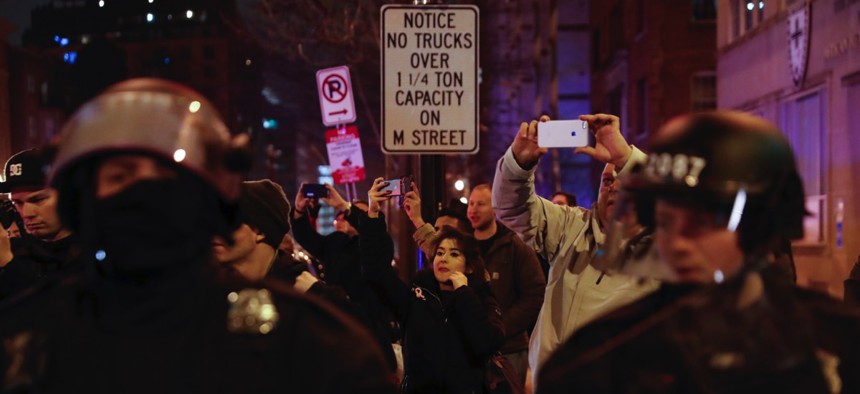This Tool Helped D.C. Police Better Allocate Resources Throughout Inauguration Weekend

Pedestrians take photos of riot police facing off with protesters during a demonstration in Washington on Friday, after the inauguration of President Donald Trump. AP Photo / John Minchillo
Geospatial data aggregation informs day-to-day police work and security for large events.
WASHINGTON — While this certainly wasn’t its first rodeo in managing large-scale public events, the Metropolitan Police Department in the nation’s capital had its hands full with Friday’s presidential inauguration and subsequent protests.
The District of Columbia already has an array of cameras surveilling the city—bolstered by a public-private partnership with local businesses to pull in their footage—but MPD also employs a visualization suite to aggregate sensors such as these on one interface.
Utilized in MPD’s day-to-day operations for several years, Hitachi Visualization Suite provides geospatial context for disparate information feeds like 911 calls and gunshot sensors.
“Police want tactical and strategic intelligence on known and developing threats so they can redeploy their resources accordingly and keep the city running as smoothly as possible,” said Chris Jensen, CI3 Solutions director at Reston, Virginia-based Hitachi Data Systems Federal.
Hitachi’s tool provides for viewing of live and recorded video and limited, and MPD also has some license plate reader capabilities. And being tied to the force’s records management system means the suite can be used for crime mapping.
Many cities national face manpower issues with their police departments, so mapping is essential in identifying hotspots, where cops should absolutely be deployed.
Because cities already invest a lot of resources into video and gunshot-detection systems, software that aggregates existing sensors must work seamlessly with them.
Information overload can be a challenge, so corresponding, correlating analysis is important—especially when there’s an investigation. Advanced analytics can pour through mountains of info to find only that which is necessary, so department employees don’t have to.
“Whether you’re talking about a citizen’s house that got burglarized, a homicide or an inauguration, these kinds of systems help police respond more efficiently,” Jensen said. “A vast amount of info comes in today from Twitter feeds and Snapchats as well, and it’s easy for an agency to get overwhelmed.”
Dave Nyczepir is a News Editor at Government Executive’s Route Fifty based in Washington D.C.
NEXT STORY: Do Regulations Really Kill Jobs?






